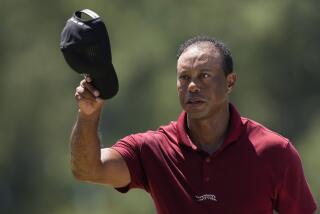The <i> Other</i> Green Shares the Lead : Ken, the One With His Sister as Caddy, and Kratzert Shoot 68s in the Masters
AUGUSTA, Ga. — Meet Kenneth J. Green of Marblehead, Conn.:
Engaging fellow. Good sense of humor. Height, 5-10. Weight, 175. Age, 27. Single. On the PGA Tour, where he earns his living, he is known as the other Green. Hubert, the one with the funny swing, is the well-known one.
Outside Connecticut and Grand Blanc, Mich., a suburb of Flint where he won the Buick Open last summer, Ken Green is as well known as, say, Adrian Stills, Dave Rummells, Peter Senior and Greg Twiggs, some other famous names on the tour.
But Thursday, in the first round of the 50th Masters tournament, Green became better known. He shot a 68, four under par, tying Bill Kratzert for the lead on a day when a strong wind made playing conditions uncommonly difficult for most of the 88 players.
It was at times a three- and four-club wind, Ben Crenshaw said. The greens, already fast, dried out and became nearly as slick as the Forum hockey rink.
Under those conditions, some horrendous scores were shot.
Arnold Palmer, Hal Sutton and Denis Watson had 80s. Mac O’Grady shot an 82. The tour’s leading money winner this year, John Mahaffey, had a 79. So did Isao Aoki. Lanny Wadkins shot a 78, and Lee Trevino, Hale Irwin and British Open champion Sandy Lyle had 76s.
Only 16 players broke par. Among them were Gary Koch and Tze-Chung Chen of Taiwan at 69, Tom Watson, Greg Norman and Tom Kite at 70, and Ben Crenshaw, Severiano Ballesteros and Hubert Green at 71.
Defending champion Bernhard Langer, Jack Nicklaus, Craig Stadler and Raymond Floyd came in at 74. On this course, they still have a shot at the first major prize of the year. Curtis Strange, who opened with an 80 last year and almost won the tournament, started this one with a 73.
A roomful of reporters waited to hear what Ken Green had to say after his round, which went up and down like some of the greens at Augusta National.
The first thing he told them was: “I am not an unknown. Everybody in Connecticut and my family knows me. I also have color. I want you to write that.”
Then he talked about all the “no-brainers,” meaning long putts, he sank and how his sister, Shelley, gets more ink than he does. “She’s had seven interviews this week, and this is my first,” he said.
Shelley has gotten a lot of ink here this week because she is her brother’s caddy. A woman carrying clubs is about as common at Augusta National as a member wearing a red jacket.
Once upon a time, players at the Masters had to use caddies supplied by the club. The players didn’t like the idea much, claiming they could play better if they were allowed to bring their own caddies.
So the club approved their request a few years ago, setting the stage for what happened Thursday. One co-leader had a sister for a caddy and the other had a buddy.
Kratzert fired his caddy of two years, Jim Johnson, Wednesday and had a friend, Chuck Hofias, carry his bag Thursday.
Carrying Jack Nicklaus’ bag was his son, Jack II, and Ballesteros brought his brother, Vincent, over from Spain to haul his.
How much help are caddies? “When it comes to golf, Shelley has no clue,” Green said. On No. 13, where he made a birdie 4 by hitting a 3-wood second shot off a side-hill lie onto the green, Green asked his sister if he should shoot for the green. She said no.
“So I went for it,” he said.
Shelley has been carrying her brother’s clubs for two years. “We have a good time out there,” he said. “She is good for me because I can talk to her and say things I can’t say to the average caddy. She won’t repeat anything.”
He hired his sister, he quipped, to save money. “She did it for the hell of it at first,” he said. “Then she decided she liked it. She was a bookkeeper, and that was no fun.”
Green made seven birdies, mainly on the strength of his no-brainers, despite the cold wind that raked the course on a sunny, chilly day. “What can I say, guys, I made some putts,” he said. He also had three bogeys.
On No. 1, he “popped in a 40-footer, give or take a couple of inches.” At No. 5, he knocked his second shot about 10 yards short of the green and putted the ball “up, up, up, and down and in” for a birdie. “It must have been 70 feet,” he said.
At No. 6, he made a birdie putt of 12 feet, and at No. 16, he made a birdie putt from about 50 feet. “That one was pretty impressive,” he said.
He hit a line drive with a 6-iron for his second shot at No. 18, and the ball rolled between two bunkers and stopped off the back edge of the green.
“I skulled my second shot, and the ball never got more than 10 feet off the ground,” he said. “But I drained a 35-footer there for another birdie.”
Green has lost his playing privileges twice on the tour and struggled for three years before winning his first tournament at Grand Blanc. He took up golf at 12 when his family moved to Honduras. His father was the principal of the American school.
He had two choices there. “I could play soccer or golf,” he said. “I didn’t want to kick the ball, so I just went to golf.”
Once too tense and nervous on the course for his own good, he decided to be himself. “I’m really a laid-back kind of guy,” he said.
He is playing in his first Masters and trying hard not to choke. “I am not impressed with Magnolia Lane,” he said.
Recognition has not come easily for this other Green. He said that a female spectator watching him play a practice round with Hubert here the other day wondered aloud, “Why does Hubert Green have two caddies?”
One way to beat the wind Thursday was to sink a lot of putts. Kratzert was one who did.
“I putted today probably as well as anyone could putt here,” he said.
At No. 1, for example, he knocked a birdie putt in from 60 feet. He also sank one from 20 feet at No. 13.
“Club selection was difficult,” he said. “You had to make sure you knew what the wind was doing.”
Watson, a skillful player in the wind, said the trick at Augusta National “is to wait for the wind to do what you know it’s going to do. It was very severe at times.”
Langer said the wind cost him four or five shots because it was so difficult to choose the right club. “I played well and had a terrible score,” he said.
On No. 1, he hit his second shot with a 1-iron. Usually, it is anything from a wedge to a 5-iron for him, he said.
“The golf course, I believe, was very tough,” Ballesteros said.
On the speed of the greens, he said: “This course can dry up in two hours like a hell.”
Was he worried about being three strokes behind the leaders?
“We haven’t even started yet,” he replied.
Masters Notes Cheryl Ann Kratzert, wife of first-round leader Bill Kratzert, believes that love is lovelier the second time around. “We were married, then we got divorced, then we got married again,” she said. “The first one was a mulligan.” . . . Although Kratzert declined to explain why he had fired caddy Jim Johnson on the eve of the tournament, Cheryl Ann said Johnson and her husband argued over club selection at last week’s Greater Greensboro Open in North Carolina, and after nine holes Johnson threw down his jacket and bag of clubs and walked off. The two settled their differences, but when the caddy showed up for work Wednesday 90 minutes late, Kratzert canned him. . . . Co-leader Ken Green’s sister and caddy, Shelley, referred to herself as the only Masters caddy in blue eye-liner, then struck a pose modeling her baggy shorts and said: “The new look at the Masters this year: Droopy drawers.” . . . Speaking of baggy, former UCLA golfer Corey Pavin, one of 16 golfers who broke par, said he wears a size-37, if anyone needs to fit him for a green jacket this week. “If the one they have is too big, I can wait for the alterations,” Pavin said. “I wonder what size Craig Stadler’s was (in 1982). It must have looked like a nightgown.”
More to Read
Go beyond the scoreboard
Get the latest on L.A.'s teams in the daily Sports Report newsletter.
You may occasionally receive promotional content from the Los Angeles Times.










